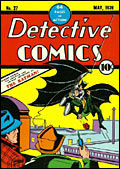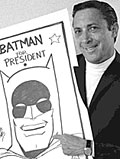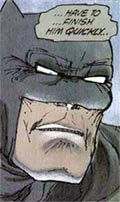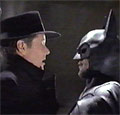Batman Multimedia |
|
 |
Watch a clip from Batman, the TV series, in which Eartha Kitt stars as Catwoman. (© 1967 Greenway Productions Inc. and 20th Century-Fox Television Inc.) |
 |
Watch a clip from Batman, the TV series, in which Burgess Meredith stars as The Penguin. (© 1967 Greenway Productions Inc. and 20th Century-Fox Television Inc.) |
 |
Watch a clip from Batman, the 1989 Tim Burton film, with Michael Keaton as Batman and Kim Basinger as Vicki Vale. (© 1989 Warner Brothers Home Video) |
 |
Listen to The Batman Theme by Danny Elfman from the 1989 film. |
 |
Batman
 Listen to Jon Kalish's report. Listen to Jon Kalish's report. Watch Batman video clips. Watch Batman video clips. Listen to the theme song of the 1960s Batman TV series. Listen to the theme song of the 1960s Batman TV series. |
June 17, 2002 -- Pity not poor Batman, the most un-super of superheroes. Sure, he can't fly. He's not an alien. He has no radioactive spider venom running through his veins. But somewhere under that dark cape lies the heart of a hero. And between those pointy ears, the swift, capable mind of a vigilante out for justice.
Batman has many familiar forms, and not just because his alter-ego, millionaire Bruce Wayne, is as stylish and glamorous as his darker half is mysterious and brooding.
As part of Present at the Creation, NPR looks at the history of this conflicted superhero, whose origins stretch as far back as 1939, in the mind of an 18-year-old comic book artist. Jon Kalish reports for Morning Edition on the many faces behind the mask.
When Batman made his debut in issue #27 of Detective Comics, swinging from a rope with a crook clutched under his arm, the occasion was momentous not because of the superpowers being demonstrated, but for the character of the hero.
As imagined by Bob Kane, the comics wonder boy who dreamed him up, Batman had violent crime in his blood. As a young boy, he had witnessed the murder of his parents. And unlike other conventionally good-vs-evil superheroes with more spectacular or otherworldly talents, Kane's hero was always just a step away from criminal behavior himself.
Frank Miller, who took on the challenge of recreating Batman in his 1986 graphic novel The Dark Knight Returns, says that this ambiguity is a big part of the appeal. "He's got this gorgeous streak of malice running through him that makes him a really exciting character," Miller says. "He's not a role model. He's not here to tell us how to behave. He's a scary fantasy."
The fantasy began under the influence of some pretty disparate sources. In a 1990 interview with Fresh Air's Terry Gross, Kane revealed the origins of the idea. Kane, who died at the age of 83 in 1998, said that the bat wings came from a sketch out of a book of drawings by Leonardo da Vinci, who had grafted them onto a sled to form a flying apparatus. The notation, Kane remembers, read: "Your bird shall have no other model but that of a bat."
If Leonardo helped to shape the costume, the other major influence gave Batman his dual identity. It was The Mark of Zorro, with Douglas Fairbanks Sr.
"During the day he was a bored count in Southern California in the 1880s," Kane says, explaining the influence on his own creation, "and at night he became a crusader fighting against the injustices of the dictatorship of that time."
Like the masked swashbuckler before him, Batman also became a television hero, swinging onto screens in the 1960s. But in this version, most of the darkness was drained out of the scenario, as Batman and Robin, the boy wonder, battled a preening cadre of super-villains bent on taking over the world. Batman still didn't have any superpowers, but the show featured his array of gadgets, from his ever-present utility belt to the Batarang and the rocket-fueled Batmobile.
The TV show (still featured nightly on cable), along with the 1966 movie, may have been all bright colors, tight costumes and choreographed fights with the words "POW!" and "BAM!" exploding onto the screen every time the heroes landed a punch, but it couldn't repress Batman's essential darkness forever.
Miller's The Dark Knight Returns sent Batman back to the streets, emphasizing the aspects of vigilantism around which his air of mystery revolved. The rebirth was such a success that it became the basis for the 1989 blockbuster movie, directed by Tim Burton.
Since that time, there have been three other live-action Batman films, ranging in tone from dark and scary to campy and full of one-liners, with another yet in the works. Batman has also come to television screens in animated series, and of course, still appears regularly in comic books.
Miller says that this staying power assures Batman's place as a heroic icon. "There will be characters that capture the public imagination for even a generation and then fade," he says. "Whereas other ones just keep getting reborn. We can't shake Robin Hood. The same with Superman. The same with Batman."
In Depth
 Listen to a 1990 Fresh Air interview with Batman creator Bob Kane.
Listen to a 1990 Fresh Air interview with Batman creator Bob Kane.
Other Resources
• See early Batman comic book covers at the Golden Age Batman Web site.
• Learn about Batman artists and see examples of their work.
• See current Batman comics at the DC Comics Web site.
• Read a biography of Batman creator Bob Kane.
• Learn more about Batman and other comic book characters on the Toonopedia Web site.
• The 1966 Batman TV Tribute Site has the history of the show, video clips, profiles of heros, villains and guest stars, information on Bat Vehicles and trivia.
• Read excerpts from Batman: The Complete History.
• The Batman: The Animated Series Web site includes character bios and an episode guide.
• The Web site for Batman Beyond, the latest animated Batman TV series, includes a Batman timeline.
• The Adam West Web site includes a biography of the Batman TV star.
• Review Batman references on The Simpsons.
Batman has many familiar forms, and not just because his alter-ego, millionaire Bruce Wayne, is as stylish and glamorous as his darker half is mysterious and brooding.
As part of Present at the Creation, NPR looks at the history of this conflicted superhero, whose origins stretch as far back as 1939, in the mind of an 18-year-old comic book artist. Jon Kalish reports for Morning Edition on the many faces behind the mask.
When Batman made his debut in issue #27 of Detective Comics, swinging from a rope with a crook clutched under his arm, the occasion was momentous not because of the superpowers being demonstrated, but for the character of the hero.
As imagined by Bob Kane, the comics wonder boy who dreamed him up, Batman had violent crime in his blood. As a young boy, he had witnessed the murder of his parents. And unlike other conventionally good-vs-evil superheroes with more spectacular or otherworldly talents, Kane's hero was always just a step away from criminal behavior himself.
Frank Miller, who took on the challenge of recreating Batman in his 1986 graphic novel The Dark Knight Returns, says that this ambiguity is a big part of the appeal. "He's got this gorgeous streak of malice running through him that makes him a really exciting character," Miller says. "He's not a role model. He's not here to tell us how to behave. He's a scary fantasy."
The fantasy began under the influence of some pretty disparate sources. In a 1990 interview with Fresh Air's Terry Gross, Kane revealed the origins of the idea. Kane, who died at the age of 83 in 1998, said that the bat wings came from a sketch out of a book of drawings by Leonardo da Vinci, who had grafted them onto a sled to form a flying apparatus. The notation, Kane remembers, read: "Your bird shall have no other model but that of a bat."
If Leonardo helped to shape the costume, the other major influence gave Batman his dual identity. It was The Mark of Zorro, with Douglas Fairbanks Sr.
"During the day he was a bored count in Southern California in the 1880s," Kane says, explaining the influence on his own creation, "and at night he became a crusader fighting against the injustices of the dictatorship of that time."
Like the masked swashbuckler before him, Batman also became a television hero, swinging onto screens in the 1960s. But in this version, most of the darkness was drained out of the scenario, as Batman and Robin, the boy wonder, battled a preening cadre of super-villains bent on taking over the world. Batman still didn't have any superpowers, but the show featured his array of gadgets, from his ever-present utility belt to the Batarang and the rocket-fueled Batmobile.
The TV show (still featured nightly on cable), along with the 1966 movie, may have been all bright colors, tight costumes and choreographed fights with the words "POW!" and "BAM!" exploding onto the screen every time the heroes landed a punch, but it couldn't repress Batman's essential darkness forever.
Miller's The Dark Knight Returns sent Batman back to the streets, emphasizing the aspects of vigilantism around which his air of mystery revolved. The rebirth was such a success that it became the basis for the 1989 blockbuster movie, directed by Tim Burton.
Since that time, there have been three other live-action Batman films, ranging in tone from dark and scary to campy and full of one-liners, with another yet in the works. Batman has also come to television screens in animated series, and of course, still appears regularly in comic books.
Miller says that this staying power assures Batman's place as a heroic icon. "There will be characters that capture the public imagination for even a generation and then fade," he says. "Whereas other ones just keep getting reborn. We can't shake Robin Hood. The same with Superman. The same with Batman."
In Depth
 Listen to a 1990 Fresh Air interview with Batman creator Bob Kane.
Listen to a 1990 Fresh Air interview with Batman creator Bob Kane.
Other Resources
• See early Batman comic book covers at the Golden Age Batman Web site.
• Learn about Batman artists and see examples of their work.
• See current Batman comics at the DC Comics Web site.
• Read a biography of Batman creator Bob Kane.
• Learn more about Batman and other comic book characters on the Toonopedia Web site.
• The 1966 Batman TV Tribute Site has the history of the show, video clips, profiles of heros, villains and guest stars, information on Bat Vehicles and trivia.
• Read excerpts from Batman: The Complete History.
• The Batman: The Animated Series Web site includes character bios and an episode guide.
• The Web site for Batman Beyond, the latest animated Batman TV series, includes a Batman timeline.
• The Adam West Web site includes a biography of the Batman TV star.
• Review Batman references on The Simpsons.


Batman made his debut in the May 1939 issue of Detective Comics.
Photo courtesy Golden Age Batman.
View enlargement.
 Bob Kane, seen here in an undated photo, created Batman when he was 18.
Bob Kane, seen here in an undated photo, created Batman when he was 18.Photo courtesy POV Online.

Adam West starred as Batman in the campy TV series.
Photo: © 1967 Greenway Productions Inc. and 20th Century-Fox Television Inc.
 Batman as a brooding vigilante in Frank Miller's 1986 graphic novel, The Dark Knight Returns.
Batman as a brooding vigilante in Frank Miller's 1986 graphic novel, The Dark Knight Returns.Photo: © 1986 DC Comics, Warner Books.

Michael Keaton as Batman comes face to face with Jack Nicholson as Jack Napier/The Joker in the 1989 film.
Photo: © 1989 Warner Brothers Home Video.